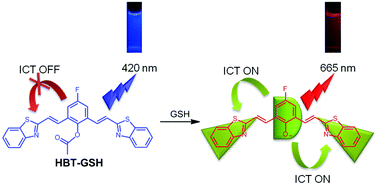Development of a near-infrared ratiometric fluorescent probe for glutathione using an intramolecular charge transfer signaling mechanism and its bioimaging application in living cells†
Abstract
A novel near-infrared (NIR) ratiometric fluorescent probe HBT-GSH derived from conjugated benzothiazole was developed for the selective detection of glutathione (GSH) over cysteine (Cys) and homocysteine (Hcy). The probe was sophisticatedly designed based on the GSH selectively induced enhancement of intramolecular charge transfer (ICT) fluorescence. It was synthesized by masking the active phenol group of 2,6-bis(2-vinylbenzothiazolyl)-4-fluorophenol through an acetyl group that acts both as a trigger of the ICT fluorescence and as a recognition moiety for GSH. On its own, the probe HBT-GSH exhibited strong blue fluorescence emission at 426 nm and weak NIR fluorescence emission at 665 nm in aqueous solution, whereas the NIR fluorescence was significantly enhanced and the short emission decreased upon the addition of GSH. Thus an NIR ratiometric fluorescent probe for GSH was developed based on the GSH-selective removal of the acetyl group, therefore switching on the ICT in HBT-GSH. The fluorescence intensity ratio (I665 nm/I426 nm) showed a linear relationship with a GSH concentration of 0–100 μM with a detection limit of 0.35 μM. Moreover, the fluorescent probe was successfully used for the ratiometric fluorescence bioimaging of GSH in living cells.



 Please wait while we load your content...
Please wait while we load your content...